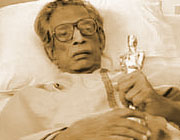| Ray, Satyajit
 |
Date of birth
2 Maj 1921, Calcutta, India
Date of death
23 April 1992, Calcutta, India
Mini biography
Satyajit Ray (2 May 1921 – 23 April 1992)
Satyajit Ray was an Indian Bengali filmmaker. He is regarded as one of the greatest auteurs of 20th century cinema.
Ray was born in the city of Calcutta (now Kolkata) into a Bengali family prominent in the world of arts and literature.
Starting his career as a commercial artist, Ray was drawn into independent filmmaking after meeting French filmmaker Jean Renoir and viewing the Italian neorealist film The Bicycle Thief (1948) during a visit to London.
Ray directed thirty-seven films, including feature films, documentaries and shorts. He was also a fiction writer, publisher, illustrator, graphic designer and film critic.
“What is attempted in these films is of course a synthesis. But it can be seen by someone who has his feet in both cultures. Someone who will bring to bear on the films involvement and detachment in equal measure.”
Ray's first film, Pather Panchali (1955), won eleven international prizes, including Best Human Document at the Cannes film festival. Alongside Aparajito (1956) and Apur Sansar (1959), the three films form The Apu Trilogy. Ray did the scripting, casting, scoring, cinematography, art direction, editing and designed his own credit titles and publicity material.
Ray received many major awards in his career, including 32 Indian National Film Awards, a number of awards at international film festivals and award ceremonies, and an Academy Honorary Award in 1991.
Satyajit Ray's ancestry can be traced back for at least ten generations. Ray's grandfather, Upendrakishore Ray was a writer, illustrator, philosopher, publisher, amateur astronomer and a leader of the Brahmo Samaj, a religious and social movement in nineteenth century Bengal.
Sukumar Ray, Upendrakishore's son, was a pioneering Bengali writer of nonsense rhyme and children's literature, an illustrator and a critic. Ray was born to Sukumar and Suprabha Ray in Kolkata. Sukumar Ray died when Satyajit was barely three, and the family survived on Suprabha Ray's meager income.
Ray studied at Ballygunge Government High School, Calcutta, and then completed his B.A. (Hons.) in economics at Presidency College of the University of Calcutta, though his interest was always in fine arts. In 1940, his mother insisted that he study at the Visva-Bharati University at Santiniketan, founded by Rabindranath Tagore.
Ray was reluctant due to his love of Kolkata, and due to the generally low opinion of the intellectual life at Santiniketan. His mother's persuasion and his respect for Tagore finally convinced him to try this route.
In Santiniketan, Ray came to appreciate oriental art. He later admitted that he learnt much from the famous painters Nandalal Bose and Benode Behari Mukherjee on whom Ray later produced a documentary film, "The Inner Eye". With visits to Ajanta, Ellora and Elephanta, Ray developed an admiration for Indian art.
In 1943, he joined a British-run advertising agency, D.J. Keymer, as a "junior visualiser", earning just eighty rupees a month. Although on the one hand, visual design was something close to Ray's heart and, for the most part, he was treated well, there was palpable tension between the British and Indian employees of the firm (the former were much better paid), and Ray felt that "the clients were generally stupid".
Soon after, Ray also became involved with Signet Press, a new publishing house started up by D. K. Gupta. Gupta asked Ray to create cover designs for books published from Signet Press and gave him complete artistic freedom. Ray designed covers for many books, including Jim Corbett's Maneaters of Kumaon, and Jawaharlal Nehru's Discovery of India.
He also worked on a children's version of Pather Panchali, a classic Bengali novel by Bibhutibhushan Bandopadhyay, renamed as Am Antir Bhepu (The mango-seed whistle). Ray was deeply influenced by the work, which became the subject of his first film. In addition to designing the cover, he illustrated the book; many of his illustrations ultimately found their place as shots in his groundbreaking film.
Along with Chidananda Dasgupta and others, Ray founded the Calcutta Film Society in 1947, through which he was exposed to many foreign films. Throughout this time, Ray continued to watch and study films seriously.

He befriended the American GIs stationed in Kolkata during World War II, who would inform him of the latest American films showing in the city. He came to know a RAF employee, Norman Clare, who shared Ray's passion of films, chess and western classical music.
In 1949, Ray married Bijoya Das, his first cousin and longtime sweetheart. The couple had a son, Sandip, who is now a film director. In the same year, Jean Renoir came to Kolkata to shoot his film The River. Ray helped him to find locations in the countryside.
It was then that Ray told Renoir about his idea of filming Pather Panchali, which had been on his mind for some time, and Renoir encouraged him to proceed.
In 1950, Ray was sent to London by D.J. Keymer to work at its head office. During his three months in London, he watched 99 films. Among these was the neorealist film Ladri di biciclette Bicycle Thieves (1948) by Vittorio De Sica which had a profound impact on him. Ray later said that he came out of the theater determined to become a filmmaker.
Director - Selected filmography
-
The Home and the World | Ghare-Baire (1984)
-
The Chess Players | शतरंज के खिलाड़ी | Shatranj Ke Khilari (1977)
-
Sonar Kella (1974)
-
Days and Nights in the Forest - Aranyer Din Ratri (1970)
-
The Lonely Wife | Charulata (1964)
-
The Big City | Mahanagar (1963)
-
Teen Kanya - Two Daughters (1961)
-
Apur Sansar (The World of Apu) (1959)
-
Jalsaghar - The Music Room (1958)
-
Aparajito | The Unvanquished (1956)
-
THE APU TRILOGY (1955-1959)
-
Pather Panchali | Song of the Little Road (1955)
|

